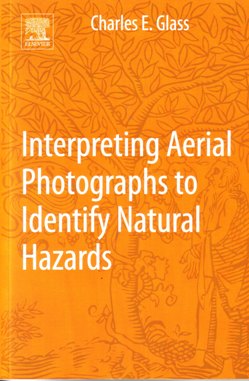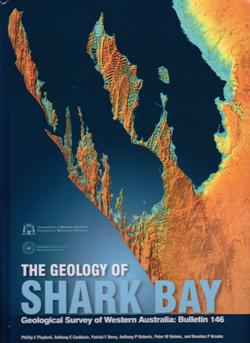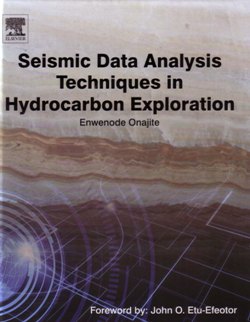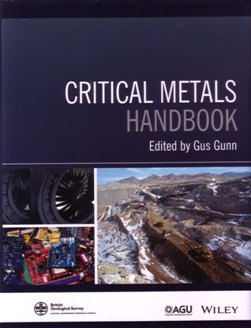Interpreting Aerial Photographs to Identify Natural Hazards

This small softback is written in a rather informal style and contains many diagrams, references and colour photographs. It examines the fundamental principles of aerial photography such as measurements in the Ultraviolet, Near Infrared, Thermal Infrared, and Microwave Regions. The author also discusses details of how aerial photographs are collected.
First there is a brief discussion of the theory of light with just enough maths to explain absorption, reflectance etc. It explores the problems that may occur with aerial photographs compared with maps and how these can be counteracted (e.g. issues with optics and elevation). It considers the best sort of film or other sensor to use.
On the hazards front, the book concentrates on natural (e.g. earthquakes, faults, landslides, floods and ground subsidence) rather than man-made ones. The author gives examples of how to interpret aerial photographs for these hazards and how not to miss potentially dangerous aspects that the untrained eye might overlook. He considers the best representational formats for recognising natural hazards, concluding that stereoscopic images are generally better.
The author makes the important point that aerial photographs can save a lot of expensive fieldwork. He considers factors such as developing drainage patterns which are useful in interpreting the photograph, and despite the emphasis on natural hazards that landscape traces of human activities such as mining, roads, railways and excavations are briefly mentioned. The book is suitable for use by students, professional scientists, engineers, estate managers, developers, construction personnel, land use planners, lawyers, archaeologists, national, county, and local policy makers and regulators.
Whether they are indicated by natural terrain, geology, vegetation, hydrology or land use patterns – it is important to recognise dangerous conditions when and where they occur. While the book offers instruction in recognising dangers it also gives examples of items which can prove problematic and argues strongly against making snap judgements. Things are not always as they at first seem!
Failure to recognise and characterise geomorphic, geologic and hydrologic dangers on the ground from aerial photography can contribute materially to the seriousness of natural disasters, damage to architectural structures, and the subsequent loss of human life. Aerial photographs provide one of the most wide-scale, inexpensive and valuable tools to those with the knowledge and experience to use them.
In summary, this book is well-written and colloquial. It is suitable for many and good value.
Reviewed by Steve Rowlatt
INTERPRETING AERIAL PHOTOGRAPHS TO IDENTIFY NATURAL HAZARDS
CHARLES E GLASS 2013 Published by Elsevier. Softback. ISBN 978-0-12-420018-0 164pp List Price £30.99
www.elsevier.com
The Geology of Shark Bay
 This book is another beautiful contribution from the Geological Survey of Western Australia on one of the extra special places in Western Australia, indeed the whole world. Shark Bay, a UNESCO World Heritage Site, has contributed so much to our knowledge and understanding of stromatolites and featured in many television natural history programmes that almost everyone will have heard of the place, not just Earth scientists.
This book is another beautiful contribution from the Geological Survey of Western Australia on one of the extra special places in Western Australia, indeed the whole world. Shark Bay, a UNESCO World Heritage Site, has contributed so much to our knowledge and understanding of stromatolites and featured in many television natural history programmes that almost everyone will have heard of the place, not just Earth scientists.
Although remote and sparsely populated, if you like sediments, Shark Bay is stunningly attractive – a true ‘bucket-list’ place. The GSWA has been mapping and studying the area for nearly 50 years and its results are wonderfully illustrated here, with over 430 colour photos and figures. The stromatolites themselves are given nearly 100 photos and are well described, along with an account of their discovery and significance with regard to Precambrian microbialites. The various macro-morphologies of the structures are related to local energy regime, and the internal structures to the nature of the microbial community.
There are many other features of general interest in the region apart from stromatolites. Most of the land surface is covered by sand dunes in a variety of types, well defined in digital elevation maps (DEMs). One of these is used as the front cover – really eye-catching. One section describes the remarkable tsunami deposits that occur along the coast, facing the open Indian Ocean. Boulders of limestone (calcrete) torn up from shoreline cliffs were carried up to 400 metres inland and now rest on a flat karstified surface up to 15m above present sea level.
One of the largest is 10 x 7 x 4 metres and is estimated to weigh 700 tons, demonstrating the awesome power of the waves. Another feature of sedimentological interest is the extensive Holocene Hamelin Coquina composed almost entirely of the shells of the bivalve Fragum. The coquina is disposed in a series of beach ridges, which developed over the last few 1000 years in response to intense tropical cyclones with an average frequency of around 100 years.
This book is a delight to read and delve into - lavishly produced, with easy-to-read text, and much to be gleaned from the wonderful pictures. It is also available free online as a pdf. Now everybody can see the beauty of limestones!
Reviewed by Maurice Tucker
THE GEOLOGY OF SHARK BAY
PHILLIP E PLAYFORD, ANTHONY E COCKBAIN, PATRICK F BERRY, ANTHONY P ROBERTS, PETER W HAINES AND BRENDAN P BROOKE 2013
Published by Geological Survey of Western Australia: Bulletin 146
ISSN 0508-4741, 281pp. List price: A$70 plus postage (
www.dmp.wa.gov.au), limited edition, (300). Free online:
http://geodocs.dmp.wa.gov.au
Seismic Data Analysis Techniques in Hydrocarbon Exploration

What on earth has happened to Elsevier? Can one of the largest scientific publishers on the planet no longer afford to employ copy editors?
This book could have been a useful, though rather pricy, purchase for anyone wanting to make a start on understanding how the seismic method is used in today’s oil industry. It aims to cover not merely the seismic method, but also sedimentology and oil/gas formation principles. The chapter that introduces these subjects is followed by chapters on seismic wave propagation, seismic exploration and noise in seismic data. A second section aims to deal with the sequence of seismic processing, CMP binning and sorting, deconvolution, NMO velocity analysis, DMO and stacking, residual statics and seismic migration. Finally, there is a section covering seismic interpretation methodology and (oddly late) reflection coefficients. Sadly, the text is marred throughout by misprints, curious grammatical expressions and typographic errors. It should never have been published in its present form.
Seismic processing is, of course, the art of making elegant pictures that, we hope, will provide some approximation to geological reality, and no book on the subject could succeed without plentiful illustrations. This book amply satisfies that requirement, but the author has believed too strongly that a picture can speak for itself. In many cases, only readers who already know quite a lot about the subject will understand the point that an illustration is supposed to be making. In some cases, also, the captions are simply wrong. The supposed minimum-phase wavelet shown is not minimum-phase, and the supposed zero-phase wavelet is not zero-phase, and these errors occur not just once but twice. The illustration provided of a ‘2D seismic configuration’ shows only basic single-fold coverage, and the following picture, of a ‘3D seismic configuration’, merely shows a 2D line with multi-fold CMP cover.
There are also curious omissions, of which perhaps the most important is the absence of any discussion of the use of vibration sources. Ignoring this topic gives a totally false impression of current onshore practice. It is also a missed opportunity, because the importance of information on source signature, and the uses of correlation techniques and deconvolution, can be explained with much greater ease when it is surveys made with controlled sources that are being discussed.
I cannot recommend this book as it stands. I look forward to a much revised second edition.
Reviewed by John Milsom
SEISMIC DATA ANALYSIS TECHNIQUES IN HYDROCARBON EXPLORATION
ENWENODE ONAJITE 2014. Published by Elsevier Inc. ISBN 978-0-12-420023-4 237pp List price £59.25
www.store.elsevier.com
Critical Metals handbook
 Our dependence on new technologies places increasing demands on the supply of certain elements and this has become newsworthy, making publication of this volume both timely and very welcome.
Our dependence on new technologies places increasing demands on the supply of certain elements and this has become newsworthy, making publication of this volume both timely and very welcome.
The book opens (Graedel, Gunn & Tercero Espinoza) with an informed discussion of both metal resources and the concept of criticality, reviewing American studies from the 1970s and 80s and following the debate through recent work in both Europe and the US. The authors show that criticality is very much a sliding-scale and that it is at times, highly non-linear, as shifts in favoured technologies impose rapid changes on the supply and especially, demand of the metals required to implement these technologies.
Chapter 2 (Humprhreys) concerns the mining industry and the supply of critical minerals, discussing the major producers and their operations across the globe. He discusses the supply in terms of natural, economic and institutional constraints, showing the complexity of their interrelationships with a detailed discussion of the role of China as a major supplier of these resources. Chapter 3 (Hagelüken) discusses the role of recycling in the supply chain, as it stands now and how it is likely to evolve in the future.
A good overview of metal recovery is presented alongside life cycle analysis, which is illustrated with three case studies and concludes with the need for innovation; in education (concerning sustainability) and legislative support, in addition to technological advances. Chapters 4 to 16 focus on one or more specific metal (Sb, Be, Co, Ga, Ge, In, Li, Mg, Rh, Ta, Nb, W, the lanthanides and platinum group metals) but space precludes a detailed description of each here. All chapters are highly informative, succinct and very readable and any one would stand as an authoritative review article in its own right. Together, they represent a substantial body of work.
The editor, Gus Gunn, (also a contributing author) has led his 23 co-authors from North America and Europe in producing a commendable and most enjoyable book.Overall, the text is very accessible and requires no specialist knowledge of the field; explaining the significance of its arguments and observations with great clarity. The diagrams (many in colour) are well-reproduced and highly relevant; conveying important information with a strong impact. It is a great credit to the authors, editors and publishers in these respects. It should be compulsory reading for politicians and financiers alike.
Reviewed by Mark Tyrer
CRITICAL METALS HANDBOOK
GUS GUNN (Ed.) 2014. Published by: American Geophysical Union/John Wiley, in collaboration with British Geological Survey. 439pp. List price £90.00 ISBN 978-0-470-67171-9 W:
http://eu.wiley.com/